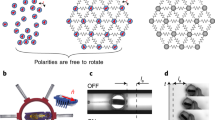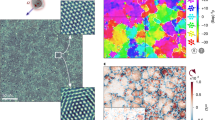Abstract
A passive solid cannot do work on its surroundings through any quasistatic cycle of deformations. This property places strong constraints on the allowed elastic moduli. In this Article, we show that static elastic moduli altogether absent in passive elasticity can arise from active, non-conservative microscopic interactions. These active moduli enter the antisymmetric (or odd) part of the static elastic modulus tensor and quantify the amount of work extracted along quasistatic strain cycles. In two-dimensional isotropic media, two chiral odd-elastic moduli emerge in addition to the bulk and shear moduli. We discuss microscopic realizations that include networks of Hookean springs augmented with active transverse forces and non-reciprocal active hinges. Using coarse-grained microscopic models, numerical simulations and continuum equations, we uncover phenomena ranging from auxetic behaviour induced by odd moduli to elastic wave propagation in overdamped media enabled by self-sustained active strain cycles. Our work sheds light on the non-Hermitian mechanics of two- and three-dimensional active solids that conserve linear momentum but exhibit a non-reciprocal linear response.
This is a preview of subscription content, access via your institution
Access options
Access Nature and 54 other Nature Portfolio journals
Get Nature+, our best-value online-access subscription
$29.99 / 30 days
cancel any time
Subscribe to this journal
Receive 12 print issues and online access
$209.00 per year
only $17.42 per issue
Buy this article
- Purchase on Springer Link
- Instant access to full article PDF
Prices may be subject to local taxes which are calculated during checkout





Similar content being viewed by others
Data availability
The data represented in Fig. 3c are available as Source Data Fig. 3. All other data that support the plots within this paper and other findings of this study are available from the corresponding author upon reasonable request.
Code availability
The code used to perform and analyse the numerics in this work is available from the corresponding author upon reasonable request.
References
van Zuiden, B. C., Paulose, J., Irvine, W. T. M., Bartolo, D. & Vitelli, V. Spatiotemporal order and emergent edge currents in active spinner materials. Proc. Natl Acad. Sci. USA 113, 12919–12924 (2016).
Lakes, R. Giant enhancement in effective piezoelectric sensitivity by pyroelectric coupling. Europhys. Lett. 98, 47001 (2012).
Lau, A. W. C., Hoffman, B. D., Davies, A., Crocker, J. C. & Lubensky, T. C. Microrheology, stress fluctuations, and active behavior of living cells. Phys. Rev. Lett. 91, 198101 (2003).
Thompson, J. M. T. ‘Paradoxical’ mechanics under fluid flow. Nature 296, 135–137 (1982).
Cui, H. et al. Three-dimensional printing of piezoelectric materials with designed anisotropy and directional response. Nat. Mater. 18, 234–241 (2019).
Polygerinos, P. et al. Soft robotics: review of fluid-driven intrinsically soft devices; manufacturing, sensing, control, and applications in human–robot interaction. Adv. Eng. Mater. 19, 1700016 (2017).
Roche, E. T. et al. A bioinspired soft actuated material. Adv. Mater. 26, 1200–1206 (2014).
Salbreux, G. & Jülicher, F. Mechanics of active surfaces. Phys. Rev. E 96, 032404 (2017).
Soni, V. et al. The odd free surface flows of a colloidal chiral fluid. Nat. Phys. 15, 1188–1194 (2019).
Banerjee, D., Souslov, A., Abanov, A. G. & Vitelli, V. Odd viscosity in chiral active fluids. Nat. Commun. 8, 1573 (2017).
Maitra, A. & Ramaswamy, S. Oriented active solids. Phys. Rev. Lett. 123, 238001 (2019).
Souslov, A., van Zuiden, B. C., Bartolo, D. & Vitelli, V. Topological sound in active-liquid metamaterials. Nat. Phys. 13, 1091–1094 (2017).
Faust, D. & Lakes, R. S. Reciprocity failure in piezoelectric polymer composite. Phys. Scripta 90, 085807 (2015).
Brandenbourger, M., Locsin, X., Lerner, E. & Coulais, C. Non-reciprocal robotic metamaterials. Nat. Commun. 10, 4608 (2019).
Coulais, C., Sounas, D. & Alù, A. Static non-reciprocity in mechanical metamaterials. Nature 542, 461–464 (2017).
Marchetti, M. C. et al. Hydrodynamics of soft active matter. Rev. Mod. Phys. 85, 1143–1189 (2013).
Lakes, R. Stable singular or negative stiffness systems in the presence of energy flux. Philos. Mag. Lett. 92, 226–234 (2012).
Prost, J., Jülicher, F. & Joanny, J. Active gel physics. Nat. Phys. 11, 111–117 (2015).
Landau, L. et al. Theory of Elasticity (Elsevier, 1986).
Lakes, R. Viscoelastic Materials (Cambridge Univ. Press, 2009).
Caruel, M. & Truskinovsky, L. Physics of muscle contraction. Rep. Progr. Phys. 81, 036602 (2018).
Hemingway, E. J. et al. Active viscoelastic matter: from bacterial drag reduction to turbulent solids. Phys. Rev. Lett. 114, 098302 (2015).
Murrell, M., Oakes, P. W., Lenz, M. & Gardel, M. L. Forcing cells into shape: the mechanics of actomyosin contractility. Nat. Rev. Mol. Cell Biol. 16, 486–498 (2015).
Beatus, T., Tlusty, T. & Bar-Ziv, R. Phonons in a one-dimensional microfluidic crystal. Nat. Phys. 2, 743–748 (2006).
Beatus, T., Bar-Ziv, R. & Tlusty, T. Anomalous microfluidic phonons induced by the interplay of hydrodynamic screening and incompressibility. Phys. Rev. Lett. 99, 124502 (2007).
Protière, S., Couder, Y., Fort, E. & Boudaoud, A. The self-organization of capillary wave sources. J. Phys. Condens. Matter 17, S3529–S3535 (2005).
Lieber, S. I., Hendershott, M. C., Pattanaporkratana, A. & Maclennan, J. E. Self-organization of bouncing oil drops: two-dimensional lattices and spinning clusters. Phys. Rev. E 75, 056308 (2007).
Lakes, R. & Wojciechowski, K. W. Negative compressibility, negative Poisson’s ratio, and stability. Phys. Status Solidi B 245, 545–551 (2008).
Starr, V. P. Physics of Negative Viscosity Phenomena (McGraw-Hill, 1968).
De Groot, S. R. Non-equilibrium Thermodynamics (North-Holland, 1962).
Avron, J. E. Odd viscosity. J. Stat. Phys. 92, 543–557 (1998).
Wiegmann, P. & Abanov, A. G. Anomalous hydrodynamics of two-dimensional vortex fluids. Phys. Rev. Lett. 113, 034501 (2014).
Day, W. A. Restrictions on relaxation functions in linear viscoelasticity. Q. J. Mech. Appl. Math. 24, 487–497 (1971).
Rogers, T. G. & Pipkin, A. C. Asymmetric relaxation and compliance matrices in linear viscoelasticity. Z. Angew. Math. Phys. 14, 334–343 (1963).
Lakes, R. Foam structures with a negative Poisson’s ratio. Science 235, 1038–1040 (1987).
Greaves, G. N., Greer, A. L., Lakes, R. S. & Rouxel, T. Poisson’s ratio and modern materials. Nat. Mater. 10, 823–837 (2011).
Bertoldi, K., Reis, P. M., Willshaw, S. & Mullin, T. Negative Poisson’s ratio behavior induced by an elastic instability. Adv. Mater. 22, 361–366 (2010).
Spadoni, A. & Ruzzene, M. Elasto-static micropolar behavior of a chiral auxetic lattice. J. Mech. Phys. Solids 60, 156–171 (2012).
Bender, C. M. & Boettcher, S. Real spectra in non-Hermitian Hamiltonians having PT symmetry. Phys. Rev. Lett. 80, 5243–5246 (1998).
Heiss, W. The physics of exceptional points. J. Phys. A 45, 444016 (2012).
Needleman, D. & Dogic, Z. Active matter at the interface between materials science and cell biology. Nat. Rev. Mater. 2, 17048 (2017).
Bi, D., Yang, X., Marchetti, M. C. & Manning, M. L. Motility-driven glass and jamming transitions in biological tissues. Phys. Rev. X 6, 021011 (2016).
Moshe, M., Bowick, M. J. & Marchetti, M. C. Geometric frustration and solid–solid transitions in model 2D tissue. Phys. Rev. Lett. 120, 268105 (2018).
Nash, L. M. et al. Topological mechanics of gyroscopic metamaterials. Proc. Natl Acad. Sci. USA 112, 14495–14500 (2015).
Offertaler, B. & Bradlyn, B. Viscoelastic response of quantum Hall fluids in a tilted field. Phys. Rev. B 99, 035427 (2019).
Woodhouse, F. G., Ronellenfitsch, H. & Dunkel, J. Autonomous actuation of zero modes in mechanical networks far from equilibrium. Phys. Rev. Lett. 121, 178001 (2018).
Acknowledgements
V.V. was supported by the Complex Dynamics and Systems Program of the Army Research Office under grant no. W911NF-19-1-0268. V.V., A.S. and W.T.M.I. acknowledge primary support through the Chicago MRSEC, funded by the NSF through grant no. DMR-1420709. A.S. acknowledges the support of the Engineering and Physical Sciences Research Council (EPSRC) through New Investigator Award no. EP/T000961/1. C.S. was supported by the National Science Foundation Graduate Research Fellowship under grant no. 1746045. W.T.M.I. acknowledges support from NSF EFRI NewLAW grant no. 1741685 and NSF DMR 1905974. D.B. was supported by FOM and NWO. P.S. was supported by the Deutsche Forschungsgemeinschaft via the Leibniz Program. We thank R. Lakes, F. Jülicher and G. Salbreux for their critical readings of the manuscript.
Author information
Authors and Affiliations
Contributions
V.V. initiated the research. C.S., A.S., W.T.M.I. and V.V. prepared the manuscript. All authors conducted the research, revised the manuscript and contributed to discussions.
Corresponding author
Ethics declarations
Competing interests
The authors declare no competing interests.
Additional information
Peer review statement Nature Physics thanks Roderic Lakes and the other, anonymous, reviewer(s) for their contribution to the peer review of this work.
Publisher’s note Springer Nature remains neutral with regard to jurisdictional claims in published maps and institutional affiliations.
Extended data
Extended Data Fig. 1 Active hinge model.
a. A honeycomb plaquette with active hinges at each vertex. Each hinge exerts an angular tension Ti based on the angular strain δθi−1 of its counterclockwise neighbor. b. A quasistatic, strain-controlled cycle in which the plaquette does work on its surroundings.
Supplementary information
Supplementary Information
Supplementary Figs. 1–10 and Discussion.
Supplementary Video 1
A microscopic illustration of a non-conservative active bond.
Supplementary Video 2
Mechanics of an overdamped odd-elastic wave.
Supplementary Video 3
Simulation of odd-elastic waves.
Supplementary Video 4
Exceptional points in odd-elastic solids.
Source data
Source Data Fig. 3
Numerical data for plots in panel c.
Rights and permissions
About this article
Cite this article
Scheibner, C., Souslov, A., Banerjee, D. et al. Odd elasticity. Nat. Phys. 16, 475–480 (2020). https://doi.org/10.1038/s41567-020-0795-y
Received:
Accepted:
Published:
Issue Date:
DOI: https://doi.org/10.1038/s41567-020-0795-y
This article is cited by
-
Three-dimensional spontaneous flow transition in a homeotropic active nematic
Communications Physics (2024)
-
Autonomous waves and global motion modes in living active solids
Nature Physics (2023)
-
Acoustic resonances in non-Hermitian open systems
Nature Reviews Physics (2023)
-
Ultra-broad bandgap induced by hybrid hardening and softening nonlinearity in metastructure
Nonlinear Dynamics (2023)
-
Information-theoretic view of the gravitational constant in Dirac’s large numbers hypothesis
Indian Journal of Physics (2023)



